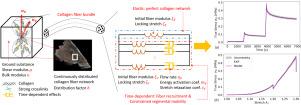Microstructure-informed hyper-viscoelastic model capturing soft tissue tensile behavior across large deformations
IF 6
2区 工程技术
Q2 MATERIALS SCIENCE, MULTIDISCIPLINARY
引用次数: 0
Abstract
Soft biological tissues exhibit highly nonlinear and time-dependent mechanical behavior arising from their complex collagen network microstructure. In this study, we present a unified, microstructure-informed hyper-viscoelastic constitutive model that captures the tensile response of soft tissues across small to large deformations under monotonic tension. The model couples a continuous fiber recruitment formulation — realized through a generalized Maxwell framework — with a physically motivated flow rule representing constrained segmental mobility. This time-dependent mechanism, inspired by reptation- and Brownian-like dynamics, captures viscoelastic relaxation governed by localized fibrillar rearrangement, interfibrillar sliding, and motion in loosely crosslinked regions. The formulation is thermodynamically consistent and includes explicit expressions for the tangent moduli to ensure computational stability in finite element simulations. The model was calibrated and validated using multi-step stress-relaxation experiments performed on human cervix specimens from both pregnant and nonpregnant individuals, revealing physiologically meaningful trends in fiber recruitment and viscoelastic properties. Notably, the model is capable of predicting faster relaxation responses using parameters calibrated from slower-relaxation data, demonstrating robustness across different strain rates. To demonstrate generalizability, the model was further applied to published datasets from rat subcutaneous tissue and bovine tendon, accurately capturing their viscoelastic responses. Compared to classical viscoelastic models, the proposed framework offers improved accuracy and mechanistic interpretability by explicitly linking macroscopic behavior to underlying collagen network structure and crosslinking density. This work provides a foundation for robust, microstructure-informed modeling of soft tissue mechanics and has broad applicability in tissue characterization and digital twin development.

微观结构信息的超粘弹性模型捕捉软组织拉伸行为跨越大变形
软体生物组织由于其复杂的胶原网状结构而表现出高度非线性和时间依赖性的力学行为。在这项研究中,我们提出了一个统一的、微观结构信息的超粘弹性本构模型,该模型捕获了在单调张力下软组织从小到大变形的拉伸响应。该模型将一个连续的纤维补充公式(通过广义Maxwell框架实现)与一个表示受限段迁移率的物理驱动流动规则耦合在一起。这种依赖时间的机制,受到重复和布朗动力学的启发,捕捉由局部纤维重排、纤维间滑动和松散交联区域运动控制的粘弹性松弛。该公式在热力学上是一致的,并且包含了切线模的显式表达式,以确保有限元模拟中的计算稳定性。该模型通过对孕妇和非孕妇宫颈标本进行多步骤应力松弛实验进行校准和验证,揭示了纤维招募和粘弹性特性的生理意义趋势。值得注意的是,该模型能够使用从慢弛豫数据校准的参数预测更快的弛豫响应,证明了在不同应变速率下的鲁棒性。为了证明其普遍性,该模型进一步应用于大鼠皮下组织和牛肌腱的公开数据集,准确地捕获了它们的粘弹性反应。与经典粘弹性模型相比,该框架通过明确地将宏观行为与潜在的胶原网络结构和交联密度联系起来,提高了准确性和机制可解释性。这项工作为强健的、微观结构的软组织力学建模提供了基础,并在组织表征和数字孪生开发中具有广泛的适用性。
本文章由计算机程序翻译,如有差异,请以英文原文为准。
求助全文
约1分钟内获得全文
求助全文
来源期刊
CiteScore
9.80
自引率
9.40%
发文量
276
审稿时长
52 days
期刊介绍:
The aim of Journal of The Mechanics and Physics of Solids is to publish research of the highest quality and of lasting significance on the mechanics of solids. The scope is broad, from fundamental concepts in mechanics to the analysis of novel phenomena and applications. Solids are interpreted broadly to include both hard and soft materials as well as natural and synthetic structures. The approach can be theoretical, experimental or computational.This research activity sits within engineering science and the allied areas of applied mathematics, materials science, bio-mechanics, applied physics, and geophysics.
The Journal was founded in 1952 by Rodney Hill, who was its Editor-in-Chief until 1968. The topics of interest to the Journal evolve with developments in the subject but its basic ethos remains the same: to publish research of the highest quality relating to the mechanics of solids. Thus, emphasis is placed on the development of fundamental concepts of mechanics and novel applications of these concepts based on theoretical, experimental or computational approaches, drawing upon the various branches of engineering science and the allied areas within applied mathematics, materials science, structural engineering, applied physics, and geophysics.
The main purpose of the Journal is to foster scientific understanding of the processes of deformation and mechanical failure of all solid materials, both technological and natural, and the connections between these processes and their underlying physical mechanisms. In this sense, the content of the Journal should reflect the current state of the discipline in analysis, experimental observation, and numerical simulation. In the interest of achieving this goal, authors are encouraged to consider the significance of their contributions for the field of mechanics and the implications of their results, in addition to describing the details of their work.

 求助内容:
求助内容: 应助结果提醒方式:
应助结果提醒方式:


